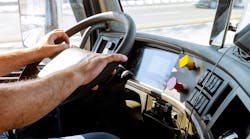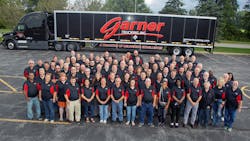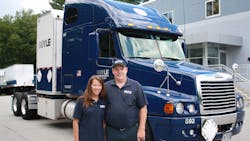For drivers to accept and benefit from new technologies, they need to understand how and why they're there. Communication about solutions is propelling performance and retention for three fleet leaders who joined this year's Commercial Vehicle Technology Conference.
“We all have the same goal, and that’s to get home safe, on time, every time,” Brad Aimone, director of driver safety and services at Central Oregon Truck Co., said during the second-annual virtual gathering.
To counteract any skepticism drivers have about new technology, panelists advised fleets to allow them to test the technology before the investment is made.
Now available: 2022 Commercial Electric Vehicle Adoption Report
“Before I invest in anything, I want them to test it, break it, tell me what’s good about it, tell me what’s bad about it,” said Sherri Garner Brumbaugh, president and CEO of Garner Trucking. ”And they talk to their peers. I don’t do anything without talking to my drivers because whatever equipment I put in the truck is going to affect them.”
Why driver buy-in is essential
On driver buy-in, Brumbaugh said it’s essential to explain how technologies will aid individual drivers, not just the fleets. When Garner Trucking began installing cameras on its trucks, drivers were accepting of forward-facing cameras, “but inward-facing in-cab cameras,” she said, “it was mutiny on the bounty.”
The company countered that apprehension by explaining that in-cab cameras also protected drivers from litigation. “In the environment that we’re in with drivers,” Brumbaugh said, referring to the driver shortage, “you don’t want to lose one driver.”
See also: What do drivers really want? Ask them.
“I didn’t lose one driver over it because we were very clear in our communication," she added. "We were very clear not only that we wanted to protect the company, but that we wanted to protect them.”
Aimone said managers will be surprised at operators’ willingness to adapt to new technology.
“When we went to cameras back in 2013, I was looking to run a pilot program with 25 drivers. I sent a message to the fleet. I figured I’m really going to have to pick to find these 25 drivers. Within 20 minutes, I had 50 drivers that volunteered.”
Michael Lasko, director of EHS and quality at Boyle Transportation, recommends having a driver advisory committee composed of both operators and department leads not only to give feedback on new tech to management but also to offer any ideas or initiatives that might interest them.
“You’re going to identify some areas that you can improve that maybe you didn’t know,” Lasko said. “We’ve seen wild success with some of the things we’ve been able to implement, whether it’s technologies that drivers want to try out, facility improvements, any number of things.”
Using data to personalize driver training
While data from telematics and safety systems is necessary to identify and correct behavior after driver error, properly schooling operators in the purpose and use of new technologies can prevent mistakes and decrease the number of reported false positives.
With data, “you can give everybody specific, individualized training that relates to an issue they have,” Lasko said. “You get much higher acceptance from the drivers when they know, ‘This is something that works for me’ rather than training them on a problem that they might not have.”
See also: How to reduce the symptoms of driver turnover
Certain solutions can even offer instruction from within the cab. “With every step we do through automated and replicated behaviors such as real-time coaching alerts and in-cab notifications, we’re able to coach drivers on what those positive behaviors are that directly impact the fleet’s overall performance,” said Danny Korrs, director of product marketing for Netradyne.
Investing in driver incentives and amenities
Offering incentives for drivers that meet or exceed safety standards can improve driver performance and retention. Garner Trucking pays drivers up to 4 more cents per mile depending on the behavior of their truck. Boyle Transportation gives its drivers an annual safety and performance bonus, as well as quarterly bonuses for completing training and bonuses related to clean roadside inspections. Netradyne’s driver profiles record drivers’ positive behaviors.
All panelists emphasized having proper facilities that offer amenities drivers need. “We try to make sure we’re rewarding the entire workforce with good-quality facilities,” Lasko said. Boyle Transportation’s facilities include a weight room and a sitting area with massage chairs.
Central Oregon Truck Co. has a deli where truckers and staff can meet and exchange ideas. “When I meet with the drivers,” Aimone said, “with orientation, I always have breakfast with them Monday morning.”
“When it comes to safety,” Brumbaugh said, “you have to measure the investment and the return on the investment. And saving a life, there’s no putting a dollar sign on that.”
CV Tech is a virtual commercial vehicle technology conference that discusses real-world technology solutions and provides a forum for fleet executives to better understand the benefits and impact of these solutions within businesses. View the recorded sessions of CV Tech 2022 here. The 2022 Commercial Electric Vehicle Adoption Report is also available.







